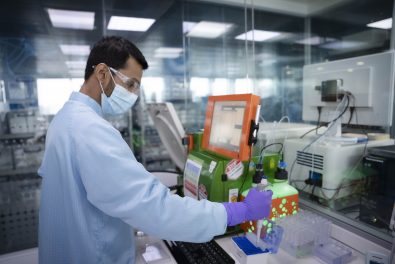Overcomming the Pitfalls of Implementing a LIMS Solution
Implementing a new LIMS is a complex and potentially disruptive project. Effective change management addresses the human and operational aspects, ensuring a smoother transition, better adoption, and maximisation of the new system’s benefits.
Our approach not only mitigates the risks associated with change but also enhances the success and sustainability of the implementation
Planning & Change Management


Understanding The Pitfalls
Implementing a Laboratory Information Management System (LIMS) can significantly enhance the efficiency and reliability of operations in commercial life science organisations.
However, the transition to a new LIMS can present considerable challenges. Biomatics can guide your organisation through these hurdles, with a special focus on improved processes, user adoption and change management.
The implementation of a new LIMS is often fraught with obstacles that can hinder its success.
Obstacles include:
- Resistance to Change:
Employees accustomed to the old system may resist transitioning to a new LIMS. This resistance often stems from a fear of the unknown and a perceived increase in workload.
- Organisational Misalignment:
Implementing a new system on existing ineffective processes will fail to achieve the benefits often expected from the new solution. Reviewing and optimising existing process needs to be a core deliverable for any new LIMS implementation.
- Poor User Adoption:
User adoption of the new system is vital. Identifying barriers to change, identifying champions, and delivering a communication strategy are crucial components of change management that help staff understand and utilise the new LIMS effectively.
- Customisation:
Over or underestimating the need to customise the LIMS to meet operational needs is often a critical issue. Too much customisation or not customising may have a similar impact. A pragmatic approach driven by operations and management is always required.
- Data Migration Challenges:
Transferring data from the old system to the new LIMS can be fraught with risks, including data loss or corruption.
The importance of reviewing existing lab processes
Reviewing existing processes when seeking to implement a new Laboratory Information Management System (LIMS) is crucial for several reasons, each aimed at ensuring the new system integrates smoothly, enhances operational efficiency, and meets the specific needs of the organisation. Here is why it’s so important:
Indentification of Current Challenges and needs
Understanding the existing processes helps to pinpoint the limitations and challenges within the current system. This could include bottlenecks in data flow, inefficiencies in sample tracking, or gaps in data reporting. By identifying these issues, an organisation can ensure that the new LIMS addresses these specific problems effectively, leading to more targeted and beneficial system features.
Ensuring Compatibility and Integration
A new LIMS must be able to integrate seamlessly with existing workflows and other software systems already in use, such as Electronic Laboratory Notebooks (ELN), Customer Relationship Management (CRM) systems, or enterprise resource planning (ERP) tools. A thorough review of existing processes helps define the technical requirements needed for this integration, such as APIs, data import/export capabilities, and system compatibility. This integration is essential for automating processes and ensuring data consistency across platforms.
Avoiding Disruption to Ongoing Operations
Implementing a new system can be disruptive to current operations. By reviewing existing processes, organisations can plan the implementation in a way that minimises downtime and disruption. This might involve a phased rollout where the LIMS is gradually integrated into live operations, allowing adjustments and training to occur without significant impact on daily workflows.
Customisation and Scalability
Every laboratory has unique needs based on its scientific focus, regulatory requirements, and operational scale. Reviewing existing processes helps in customising the LIMS to fit these specific needs. Additionally, understanding these processes allows for scalability planning, ensuring the LIMS can grow and adapt as the organisation evolves, whether it involves scaling up operations, incorporating new testing methodologies, or adapting to new regulatory requirements.
Training and User Adoption
Effective LIMS implementation is not just about the technology but also about the people who use it. Reviewing existing processes helps identify which areas will require more focused training and which features will be most beneficial to users. Understanding the daily tasks and challenges of your staff ensures that training can be specifically tailored to meet their needs, thereby enhancing user adoption and reducing resistance to the new system.
Cost and Efficiency Optimisation
Knowing the ins and outs of current processes can reveal inefficiencies and duplications that the new LIMS can eliminate, leading to cost savings and more streamlined operations. This could result in a significant return on investment as the new system improves processing times, reduces errors, and automates routine tasks.
Regulatory Compliance
In highly regulated industries like pharmaceuticals and biotechnology, compliance with standards such as FDA, GMP, GLP, or HIPAA is critical. Reviewing existing processes ensures that the LIMS is configured to maintain compliance, manage audit trails effectively, and uphold data integrity and security standards.

Eexpert Change Management
Stakeholder Engagement:
We begin by effectively engaging with all stakeholders to understand their needs and concerns, fostering an environment of cooperation and open communication. We use this engagement to shape and evolve the implementation plan.
Customised Training Programmes:
Biomatics develops customised training programmes to ensure all users are proficient with the new system. Training is designed to be engaging and relevant, increasing user comfort and competence with the LIMS.
Gradual Implementation:
Instead of a sudden switch-over, we advocate for a phased implementation approach. This allows users to gradually adapt to the new system, reducing the shock of change and allowing for adjustments based on user feedback.
Ongoing Support and Adaptation:
Change doesn’t end at implementation. Biomatics provides ongoing transition support to address any emerging issues, ensuring the LIMS continuously evolves to meet the growing needs of your business.



